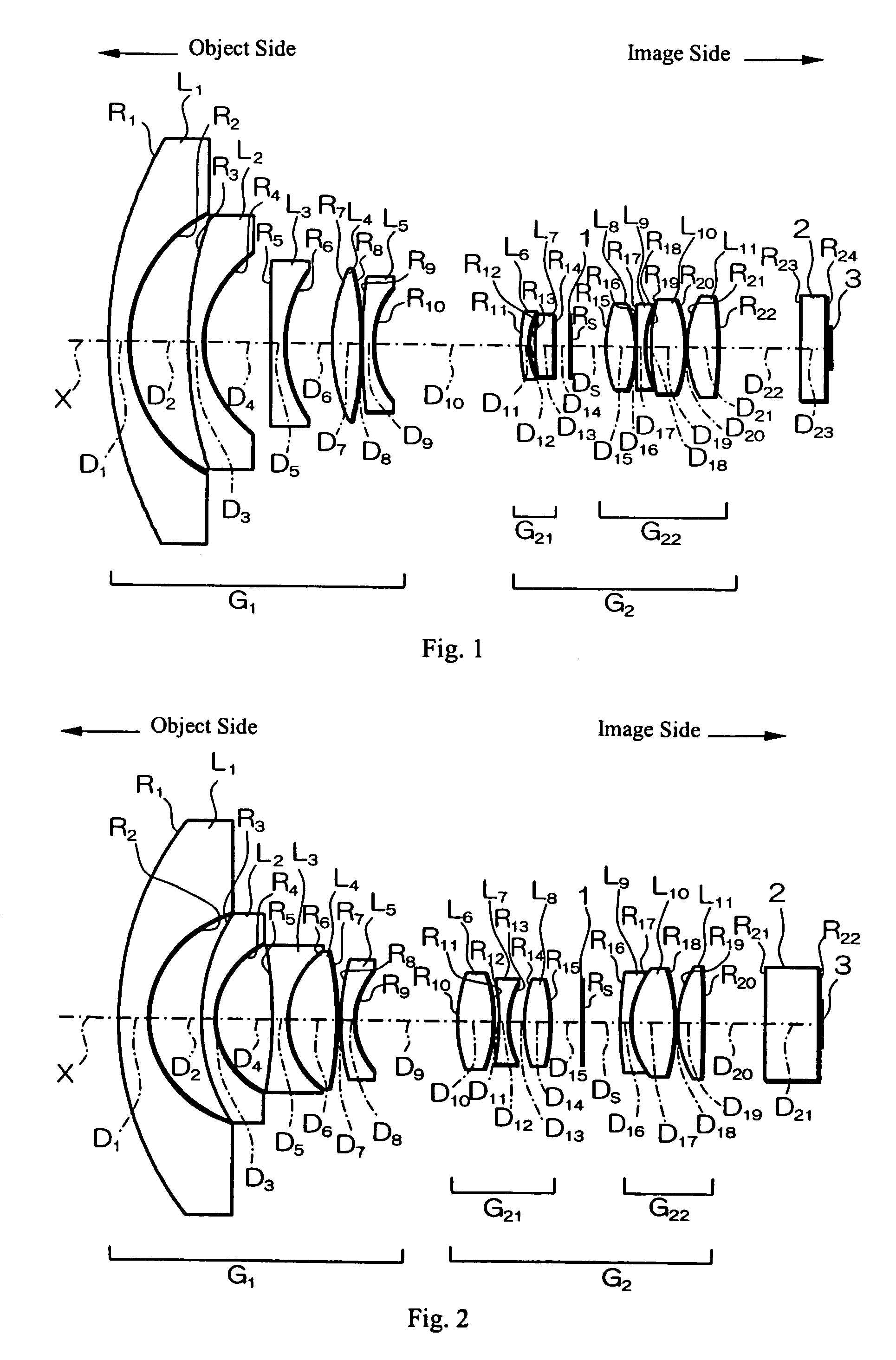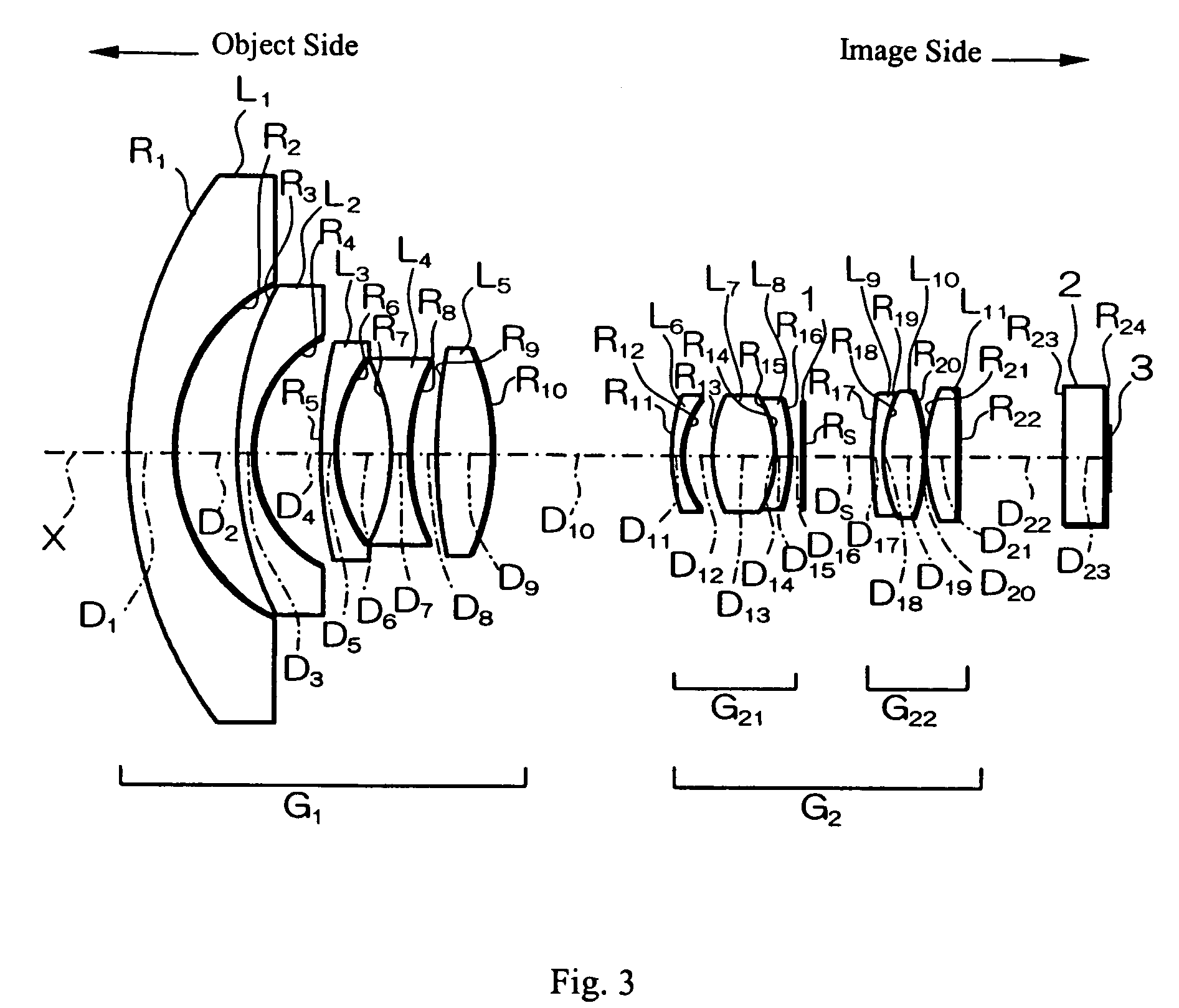Fisheye lens and imaging device using it
a technology of fisheye lens and imaging device, which is applied in the field of fisheye lens, can solve the problems of affecting the image quality of the whole imaging device, and increasing the field of view and image processing, so as to achieve compactness of the entire imaging device and improve optical performan
- Summary
- Abstract
- Description
- Claims
- Application Information
AI Technical Summary
Benefits of technology
Problems solved by technology
Method used
Image
Examples
embodiment 1
[0049]FIG. 1 shows a cross-sectional view of the fisheye lens of Embodiment 1 of the present invention. As shown in FIG. 1, the fisheye lens of Embodiment 1 includes, arranged in order from the object side, a first lens group G1 that includes five lens elements, L1–L5, and a second lens group G2 that includes, arranged in order from the object side, two lens elements, L6 and L7, that form a lens group G21, a stop 1, and lens elements L8–L11 that form a lens group G22. In Embodiment 1, all the lens elements are lens components.
[0050]Table 1 below lists the surface number # (except for the stop, which is listed as ‘Stop’) in order from the object side, the radius of curvature R (in mm) of each surface, the on-axis surface spacing D (in mm), as well as the refractive index Nd and the Abbe number vd (both at the d-line of 587.6 nm) of each optical element for Embodiment 1. Listed in the bottom portion of Table 1 are the focal length f, the f-number FNO, the half-field angle ω, the back ...
embodiment 2
[0057]Embodiment 2 is very similar to Embodiment 1 and uses the same number of lens elements and lens components. Because Embodiment 2 is very similar to Embodiment 1, Embodiment 2 is well shown by FIG. 1 and the differences between Embodiment 2 and Embodiment 1 will be evident from Table 3 that follows.
[0058]Table 3 below lists the surface number # (except for the stop, which is listed as ‘Stop’) in order from the object side, the radius of curvature R (in mm) of each surface, the on-axis surface spacing D (in mm), as well as the refractive index Nd and the Abbe number vd (both at the d-line of 587.6 nm) of each optical element for Embodiment 2. Listed in the bottom portion of Table 3 are the focal length f, the f-number FNO, the half-field angle ω, the back focal length bf, the on-axis distance EXP from the image plane to the exit pupil, and the on-axis distance Ds from the object-side surface of the object-side lens element of the fisheye lens to the image-side surface of the ima...
embodiment 3
[0065]FIG. 2 shows a cross-sectional view of the fisheye lens of Embodiment 3 of the present invention. Embodiment 3 is similar to Embodiment 1 and uses the same number of lens elements but a fewer number of lens components. As shown in FIG. 2, the fisheye lens of Embodiment 3 includes, arranged in order from the object side: a first lens group G1 that includes five lens elements, L1–L5; and a second lens group G2 that includes, arranged in order from the object side, three lens elements, L6–L8, that form a lens group G21, a stop 1, and lens elements L9–L11 that form a lens group G22. Because Embodiment 3 is very similar to Embodiment 1, the differences between Embodiment 3 and Embodiment 1 will be evident from Table 5 that follows.
[0066]Table 5 below lists the surface number # (except for the stop, which is listed as ‘Stop’) in order from the object side, the radius of curvature R (in mm) of each surface, the on-axis surface spacing D (in mm), as well as the refractive index Nd and...
PUM
 Login to View More
Login to View More Abstract
Description
Claims
Application Information
 Login to View More
Login to View More - R&D
- Intellectual Property
- Life Sciences
- Materials
- Tech Scout
- Unparalleled Data Quality
- Higher Quality Content
- 60% Fewer Hallucinations
Browse by: Latest US Patents, China's latest patents, Technical Efficacy Thesaurus, Application Domain, Technology Topic, Popular Technical Reports.
© 2025 PatSnap. All rights reserved.Legal|Privacy policy|Modern Slavery Act Transparency Statement|Sitemap|About US| Contact US: help@patsnap.com



